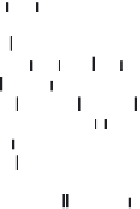Biomedical Engineering Reference
In-Depth Information
Figure 2. Motivation agent safety
emergent behavior resulting from a complex
structure of modular functionalities for action
selection in real time.
The architecture presented in this chapter
assumes character motivations as the driving
internal force of autonomous behavior. They
are considered to be the quantitative component
of the structure dynamics, and are responsible
for filtering the attention-knowledge-decision
interaction processing for action selection. This
filtering may reduce the computational complexity
of the whole process.
A character is considered here as a multi-agent
structure including both reactive and cognitive
agents. These agents are grouped according to
three basic functionalities: Motivation agents,
Cognition agents and Execution agents.
Motivation Agents are reactive and each one
represents a single motivation. They compete
with each other for priority based on their In-
tensity values. The set of all Motivation Agents
constitutes the Inner Motivational Environment
of the character. The Intensity increases autono-
mously based on a rate
m
defined at design time.
Two threshold divide the intensity range in three
zones: (a) comfort zone, where the agent is in an
inactive state; (b) tolerance zone, where the agent
goes to a competitive state, competing with other
motivations for priority; and (c) discharge zone,
where, if it does not win the competition and is
set to active state, then frustration takes place and
it has to discharge the excess of Intensity through
some of a set of predefined discharge actions,
chosen according to the context.
Higher intensity intentions win the com-
petition and can activate their correspondent
cognition agents. These agents integrate the
necessary perception, knowledge and decision-
making process for their intention satisfaction.
They can be decomposed in hierarchical trees
so as to allow sharing the common components
between different intentions, in the same way as
motivational graphs do (Chiva, Devade, Donnart,
and Maruéjouls, 2004). As intensity propagates
in these trees, they can negotiate the best way to
simultaneously satisfy many active intentions.
Special kinds of Cognition Agents, the Alert
Agents, are responsible for tracking the envi-
ronment for specific stimuli, objects or events.
They decide when a given environment element
achieves certain levels of predefined parameters
and must be considered by the character. In this
case, they activate a correspondent motivation
agent with a value associated to the urgency of
the alert. This can change the course of action of
the character in order to deal with the emergent
situation. Execution Agents run actions, which
means changing outer environment and inner

































































































































































































































Search WWH ::

Custom Search